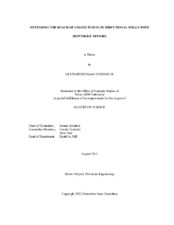| dc.description.abstract | A rigorous study has dispelled a longtime myth about coiled-tubing technology. The inability to rotate the tubing limits its reach in the lateral section of the wellbore. Past and current extended-reach techniques for coiled-tubing drilling have not been sufficient (individually) in significantly increasing the reach of the tubing in the wellbore; often four or five extended-reach methods are combined to have significant displacement in the wellbore, which is quite expensive to do.
After much rigorous investigations and computer simulation tests, the study has demonstrated that a downhole motor (second motor) can be used in significantly extending the reach of coiled tubing in the wellbore. This technique is expected to also improve hole cleaning process (during coiled-tubing drilling), since the configuration allows for the rotation of the coiled tubing string.
With the proposed technology having two tubing segments (rotating and nonrotating segments), the investigations show that the two segments will not buckle under applied torsional loads in the course of using a hydraulic downhole motor. But the nonrotating segment of the tubing string will be subjected to severe twisting.
Electric downhole motors and a dynamic torque anchor (or full-gaged stabilizer) coupled to a hydraulic motor can be used to achieve the primary aim of the technology and prevent twisting of the nonrotating segment (the twisting of the segment destabilizes the drilling process).
Although the use of a dynamic torque anchor or full-gaged stabilizer can be used in arresting the twisting moment, it induces high frictional forces, which reduce the lateral displacement of the tubing (relative to an electrodrill). To solve this problem, a new “dynamic torque arrestor” has been proposed in this project. The simulation tests show that the lateral displacements of the tubing in the wellbore (when the newly proposed dynamic torque arrestor is coupled to a hydraulic motor) are greater than the displacements achieved with the use of dynamic torque anchor or full-gaged stabilizer.
Since the proposed technology does not require the intense modification of the current configuration of the coiled tubing unit, its application will be inexpensive. | en |


